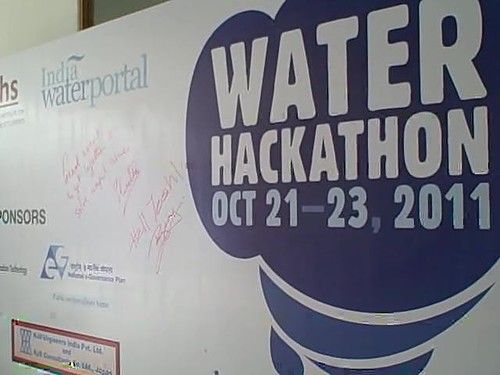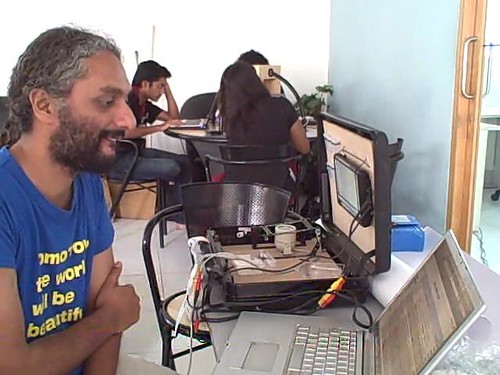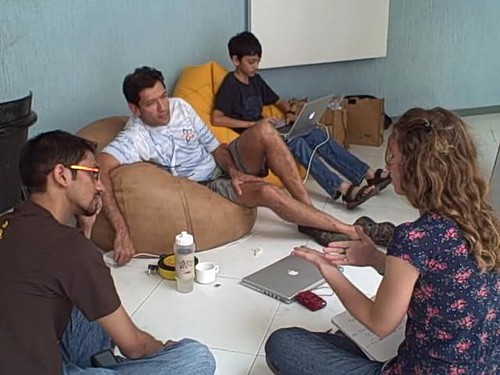My thoughts on Bangalore's First Water Hackathon
4 minsIt’s not often that one is satisfied about an event even before it has occurred. As I drove to IIIT-B (host to Bangalore’s first water hackathon) on a Sunday afternoon, I felt precisely that. A hackathon on water and sanitation… Finally… in India. I allowed myself a goofy smile. Close on the heels of the Design Public conference, which also featured Water & Sanitation as one of five Great Challenges, the hackathon assumed a special significance. My thoughts went back to a series of email and short phone conversations with Mumbai-based Atul Seksaria (a friend of a friend). Atul was passionate about organizing a hackathon on cleantech and wanted to brainstorm. We never had that brainstorming discussion but his last email (a few months ago) was gushing about how the first event exceeded his expectations. I allowed myself another smile.
Setting the stage for the Hackathon
The three main sponsors for the Water Hackathon were World Bank’s Water & Sanitation Program (WSP), IIHS (Indian Institute for Human Settlements), and India Water Portal/Arghyam. The 3-day hackathon was structured to provide context and problem statement overview on the first day – expert sessions on water and sanitation over a dinner banquet at the ISTA hotel followed by the announcement of 14 themes (complete list at bottom of this post). The 24-hour hacking session started on Sat (Oct 22) and culminated on Sun afternoon.
In the first part of the video below, the World Bank’s recently appointed Director for WSP’s New Delhi office (Jeff Martin?) talks about the genesis behind the water hackathon in India/Bangalore. The rest of the video is a working session that ultimately resulted in the creation of the 14 problem statement themes.
Over a 3-day period, water hackathons were held in 8 other cities across four continents. The WSP folks have already put out a nice update covering all the nine hackathons – Geeking out for development: WaterHackathon Generates Solutions.
Highlights and Winners
Twenty teams picked up the hacking gauntlet on Saturday and all, barring five, made their final presentations on Sunday to a 5-person jury and an audience numbering 100.
Consumer complaint and redressal turned out to be the most popular theme (8 teams), followed by toilet locators (4 teams) and water measurements (3 teams).
Nearly all the teams had Mobile as a key aspect of their hack (this was expected!). What was more surprising (to me at least!) is that nearly all the hacks with a mobile App solution were using Android. Android is clearly the Windows of the Mobile World!
The jury, which included both entrepreneurs (Atul Chitnis, Mohan Sundaram, and Amir) and water domain experts (World Bank’s Juan and Arghyam’s S. Viswanath (profiled on TechSangam earlier), ultimately came up with two categories of winners. The three category A winners were Jugaad Sensors, Peer Water Exchange (PWX), and Prithvi. The three winners from category B were S3V2K, PeeQ, and Hackers for Change. Since my top two picks (by a very wide margin) were Jugaad Sensors and PWX, I can only infer that Category A = Top 3 winners. This Water Hackathon Update post from India Water Portal lists, among other things, the team member names for the 6 winners.
Standout Winner #1: Jugaad Sensors
The team of artists and designers from the Srishti School of Design were the first team to present. With due respect to the other winning teams, this team already had my (audience) vote before the rest of the presentations even got underway. It’s a pity that the audio stream for Jugaad’s Ustream recording is missing in action. I managed to find a recording from Saturday where one of the Jugaad team members explains what they intend to do.
Relying entirely on my scribbled notes (and recollection!), here’s why Jugaad Sensors got me so excited: The cost of a complete suite of commercial sensors to test water quality (turbidity, Nitride levels, Iron levels, Ph, and Fluoride) is 2.75 lakh INR. The Jugaad team leveraged a range of inexpensive sensors and novel techniques (cheap lasers for turbidity, Ph meters from chemist shop, guava leaves and cabbage juice for iron detection, and 3 RGB LEDs for fluoride detection). Cost of their solution: a jaw-dropping 2,450 INR excluding the cost of a micro-controller). The choice of inexpensive sensory components was the first leg of their solution. The second leg was to transmit the data using an Android mobile application and the third leg was to visualize the data on a map. Their initial prototype (http://metamap.in/) gives you an idea.
Standout Winner #2: Peer Water Exchange (PWX)
PWX, an 8-year old US/India-based non-profit to select/fund/manage/track the impact of water and sanitation projects, was represented by a father-son duo and their technical architect. During the Hackathon, they built an SMS-based infrastructure on top of their existing technology stack. By assigning a unique mobile number for each project (being monitored by PWX), the SMS-based solution enables data collection from the most remote water and sanitation projects using the most primitive of mobile phones.
The 14 Problem Statements
- Monitoring and incentivizing use of community toilets in Indian cities
- Mobile phone as a policy watch application
- Awareness creation on water and sanitation issues
- Data repository and information dissemination
- Donate a toilet; donate a tap
- Inconsistent and unpredictable water supply to slums
- Locating and rating of public restrooms in Indian cities
- Customer complaint and redressal
- Policies beneficial to the citizen in her area
- Service delivery in the water and sanitation sector
- Status of applications for subsidy
- Water Lottery: linking water meters to mobile phones
- Water tankers in urban India: enhancing accountability and accessibility
- Using sport as a medium to advocate for behavior change


